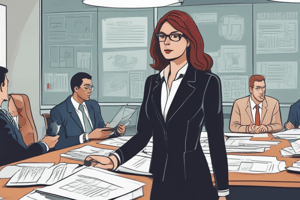Podcast
Questions and Answers
What is first-order change characterized by?
What is first-order change characterized by?
- Creating a completely new product
- Making major alterations to the existing system
- Implementing changes that disrupt order
- Addressing problems without challenging current methods (correct)
What does 'change to stay the same' refer to?
What does 'change to stay the same' refer to?
- Resisting any form of change
- Making significant alterations for improvement
- Reverting to old methods after change
- Maintaining continuity while making improvements (correct)
In the scenario provided, why is Company XYZ implementing first-order changes?
In the scenario provided, why is Company XYZ implementing first-order changes?
- To eliminate any form of resistance to change
- To revolutionize their entire business model
- To completely shut down the company operations
- To make incremental adjustments within the existing system (correct)
What is the primary focus of first-order change in the context of Company XYZ's project delays?
What is the primary focus of first-order change in the context of Company XYZ's project delays?
How does first-order change differ from second-order change?
How does first-order change differ from second-order change?
What is the central concept behind first-order change as described in the text?
What is the central concept behind first-order change as described in the text?
What is the main purpose of establishing a clear task allocation process?
What is the main purpose of establishing a clear task allocation process?
Which change is a part of the Communication Change in the FIRST ORDER CHANGE Step 3?
Which change is a part of the Communication Change in the FIRST ORDER CHANGE Step 3?
What is the purpose of introducing a communication tool like Slack or Microsoft Teams?
What is the purpose of introducing a communication tool like Slack or Microsoft Teams?
Why are training sessions conducted during FIRST ORDER CHANGE Step 4?
Why are training sessions conducted during FIRST ORDER CHANGE Step 4?
What is the purpose of weekly cross-team meetings introduced in the Coordination Change?
What is the purpose of weekly cross-team meetings introduced in the Coordination Change?
How does poor communication impact progress according to the text?
How does poor communication impact progress according to the text?
What type of change leads to organizational transformation by introducing new products, services, and ways of doing business?
What type of change leads to organizational transformation by introducing new products, services, and ways of doing business?
Which step involves collecting feedback from project teams and stakeholders regarding the effectiveness of implemented changes?
Which step involves collecting feedback from project teams and stakeholders regarding the effectiveness of implemented changes?
What is the main focus of the key performance indicators (KPIs) tracked by Company XYZ in ongoing projects?
What is the main focus of the key performance indicators (KPIs) tracked by Company XYZ in ongoing projects?
What does the expression 'move to get to a new position' refer to in the context of organizational change?
What does the expression 'move to get to a new position' refer to in the context of organizational change?
Which step involves consistently reviewing processes and seeking opportunities for further enhancement within Company XYZ?
Which step involves consistently reviewing processes and seeking opportunities for further enhancement within Company XYZ?
What characterizes second-order change in organizations based on the provided text?
What characterizes second-order change in organizations based on the provided text?
What does second-order change involve in an organization?
What does second-order change involve in an organization?
In Company ABC, what issue with decision-making did the hierarchical structure pose?
In Company ABC, what issue with decision-making did the hierarchical structure pose?
What is the first step taken by Company ABC to address the issue?
What is the first step taken by Company ABC to address the issue?
What is the vision developed by Company ABC for organizational change?
What is the vision developed by Company ABC for organizational change?
Who is involved in the discussions about the proposed second-order changes in Company ABC?
Who is involved in the discussions about the proposed second-order changes in Company ABC?
Why is it important to communicate the rationale behind second-order changes?
Why is it important to communicate the rationale behind second-order changes?
What operational innovations allowed adjusters to estimate damage and write a check on the spot?
What operational innovations allowed adjusters to estimate damage and write a check on the spot?
What are some benefits of the operational innovations mentioned in the text?
What are some benefits of the operational innovations mentioned in the text?
What type of innovation involves introducing wholly new processes and services?
What type of innovation involves introducing wholly new processes and services?
What did Amazon initially start selling when it began its operations?
What did Amazon initially start selling when it began its operations?
How did the business model developed by Amazon impact the traditional retailing sector?
How did the business model developed by Amazon impact the traditional retailing sector?
What is a key characteristic of disruptive innovations?
What is a key characteristic of disruptive innovations?
Flashcards are hidden until you start studying
Study Notes
Types of Change
- First-order change: involves a specific initiative that solves a problem, and/or makes improvements, in ways that do not present a challenge to current methods and thinking.
- Second-order change: involves making significant and transformative shifts in an organization's fundamental structures, systems, and culture.
First-Order Change
- Involves making incremental adjustments within an existing system or process to address issues or challenges.
- Examples: incorporating safety features in motor vehicles, improving project management efficiency, and enhancing communication.
- Step 1: Diagnosis and Analysis - identify root causes of the problem through surveys, interviews, and data analysis.
- Step 2: Identify Specific Changes - determine specific areas requiring change.
- Step 3: Develop and Implement Changes - introduce new processes, tools, and systems.
- Step 4: Training and Support - provide training and support to ensure successful implementation.
Second-Order Change
- Involves making significant and transformative shifts in an organization's fundamental structures, systems, and culture.
- Examples: decentralizing decision-making, developing a culture of innovation, and creating new products and services.
- Step 1: Acknowledge the Need for Transformation - recognize the limitations of the current structure and the need for change.
- Step 2: Vision and Strategy - develop a vision and strategy for the transformed organization.
- Step 3: Mobilize Support - engage stakeholders in discussions about the proposed changes.
- Step 5: Monitoring and Evaluation - track key performance indicators to monitor progress.
- Step 6: Feedback and Iteration - collect feedback and make adjustments as necessary.
- Step 7: Continuous Improvement - maintain an environment of continuous improvement.
Disruptive Innovations
- Introduce wholly new processes and services, such as an all-electric motorcar or social networking.
- Disruptive innovations imply deep transformational change.
- Examples: Amazon's business model disrupting traditional retailing, and the development of electric-powered self-driving motorcars.
Studying That Suits You
Use AI to generate personalized quizzes and flashcards to suit your learning preferences.




